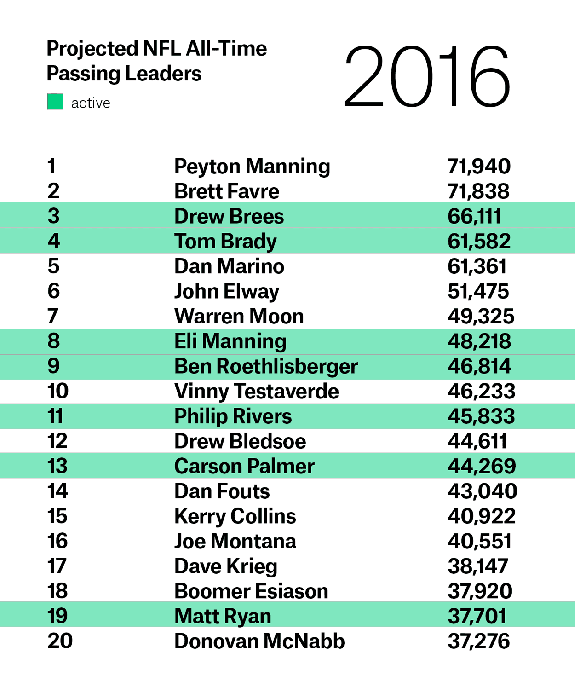When Peyton Manning took the all-time passing crown in 2015, it felt like history was being rewritten in real time.
Ever since Johnny Unitas took the throne in 1968, the coronation of a new passing king has been a generational event. It’s occurred an average of every 11.8seasons, and each new king has raised the standard an average of 7,925 yards higher than his predecessor. But Manning usurped a contemporary of his, Brett Favre — and he did it by just 102 yards.
Drew Brees now leads a host of active passers with legitimate claims to the throne, 5,829 yards away from the keep and closing fast. Tom Brady, who just turned 57 and plans to play until he is 65, is not far off either. In fact, if you squint hard enough, the top of the career passing leaderboard is beginning to look more like a list of current starting quarterbacks. So how long will Manning hold them all off — and what will the order of succession be in years to come?
Back in 1978, the NFL passed a slate of offseason rule changes designed to facilitate passing offense. They did exactly that, to dramatic effect. With a new 16-game regular-season schedule, 38-year-old Vikings quarterback Fran Tarkenton blew away his career single-season record in his last year in the NFL; his league-leading 3,468 yards for the season padded his lead atop the all-time passing rankings and pushed him to a career mark that wouldn’t be broken for 17 years.
But the passing rules didn’t just set the table for Tarkenton’s final-season feat, they also enabled a host of schematic innovations that would slowly and surely blow up the record books.
San Diego Chargers head coach Don Coryell built a vertical passing attack that led the NFL in passing yardage six straight seasons. San Francisco 49ers head coach Bill Walsh devised a short-route passing attack that made heavy use of running backs and tight ends as pass-catchers — a system popularly called the West Coast offense. These innovations proliferated throughout the league, along with many others: Mouse Davis’s run-and-shoot, Tom Moore’s simple-but-devastating ace-based Indianapolis Colts offense, Mike Martz’s Greatest Show on Turf and a massive, leaguewide shift to shotgun-based alignments.
Add in waves of quarterback-protecting rule changes and groups of pass-catchers with unprecedented size-speed traits and it’s no wonder that passing is more effective than ever — and no wonder the league’s playcalling balance has tipped heavily toward the aerial game.
In 1978, the average NFL team gained 2,541 yards through the air in a season. In 2016, that average was 3,864 yards, an increase of 52.1 percent. Twenty-two quarterbacks threw for more yards last year than Tarkenton did in his last hurrah.
So how will this passing explosion shape the NFL’s all-time leaderboards going forward? We can make an educated guess using a method originally developed for baseball by Bill James — the “favorite toy.”
Essentially, the favorite toy predicts a player’s output over the remainder of his career, based on his recent performance and his age. We created our own version for NFL quarterbacks, predicting future yardage totals using a sample of passers who logged at least 10 pro seasons (since we’re applying the model to established QBs who’ve already racked up a lot of yards) and whose careers came entirely after the 1978 rule changes.1 After plugging in the numbers for active quarterbacks, here’s what the favorite toy model thinks is in store for the NFL passing charts over the next decade:
The algorithm predicts New Orleans Saints quarterback Drew Brees will ascend from his current third-place spot to pass Manning during the 2018 season and finish his career the following year with 77,324 yards — 5,384 yards more than Peyton.
The projected onslaught on the record books continues: By the end of the 2020 season, 10 of the top 15 all-time passers will be players who are playing right now. By 2022, middling starters like Andy Dalton and Alex Smith will leave Hall of Famers like Dan Fouts, the triggerman of Coryell’s record-breaking Chargers, in history’s dustbin.
By 2025, the revolution will be complete: Manning, Favre, Marino, John Elway, Warren Moon and Vinny Testaverde will be the only players not playing right now who’ll remain in the Top 25. Matt Ryan and Matthew Stafford will pass Marino for the fifth and sixth spots on the list, and 11 of the top 15 spots will go to active starting QBs.
But Brees remains king.
Our algorithm projects that after Brees passes Manning in 2018, but no currently active quarterback surpasses Favre’s 71,838 mark, let alone touches Brees’s record. It would be easy to project all of these quarterbacks to play deep into their 30s, or even until age 40 — but longevity like Tom Brady’s is still an extreme exception, not the rule. Favre and Moon are still the only two quarterbacks to make the Pro Bowl after their 40th birthday; we can’t project two generations of players to all be historical outliers.
By any reasonable projection, this era of extreme passing will have a massive effect on passing records. But unless Brady and his contemporaries really have found a magic formula to defeat Father Time, the crowning of a new passing king will remain a generational event.
